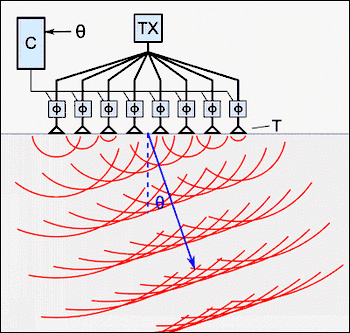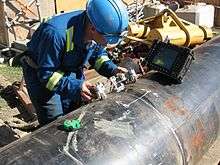Phased array ultrasonics


Phased array ultrasonics (PA) is an advanced method of ultrasonic testing that has applications in medical imaging and industrial nondestructive testing. Common applications are to noninvasively examine the heart or to find flaws in manufactured materials such as welds. Single-element (non-phased array) probes, known technically as monolithic probes, emit a beam in a fixed direction. To test or interrogate a large volume of material, a conventional probe must be physically scanned (moved or turned) to sweep the beam through the area of interest. In contrast, the beam from a phased array probe can be focused and swept electronically without moving the probe. The beam is controllable because a phased array probe is made up of multiple small elements, each of which can be pulsed individually at a computer-calculated timing. The term phased refers to the timing, and the term array refers to the multiple elements. Phased array ultrasonic testing is based on principles of wave physics, which also have applications in fields such as optics and electromagnetic antennae.
Principle of operation
The PA probe consists of many small ultrasonic transducers, each of which can be pulsed independently. By varying the timing, for instance by pulsing the elements one by one in sequence along a row, a pattern of constructive interference is set up that results in a beam at a set angle. In other words, the beam can be focused and steered electronically. The beam is swept like a search-light through the tissue or object being examined, and the data from multiple beams are put together to make a visual image showing a slice through the object.
Phased array use in the industry
Phased array is widely used for nondestructive testing (NDT) in several industrial sectors, such as construction, pipelines, and power generation. This method is an advanced NDT method that is used to detect discontinuities i.e. cracks or flaws and thereby determine component quality. Due to the possibility to control parameters such as beam angle and focal distance, this method is very efficient regarding the defect detection and speed of testing.[1] Apart from detecting flaws in components, phased array can also be used for wall thickness measurements in conjunction with corrosion testing.[2][3] Phased array can be used for the following industrial purposes:
- Inspection of welds[4]
- Thickness measurements
- Corrosion inspection
- Flaw detection
- Rolling stock inspection (wheels and axles)
Features of phased array

- The method most commonly used for medical ultrasonography.
- Multiple probe elements produce a steerable and focused beam.[5]
- Focal spot size depends on probe active aperture (A), wavelength (γ) and focal length (F).[6] Focusing is limited to the near field of the phased array probe.
- Produces an image that shows a slice through the object.
- Compared to conventional, single-element ultrasonic testing systems, PA instruments and probes are more complex and expensive.
- In industry, PA technicians require more experience and training than conventional UT technicians.
Standards
- prEN 16018, Non destructive testing - Terminology - Terms used in ultrasonic testing with phased arrays
- ISO/WD 13588, Non-destructive testing of welds – Ultrasonic testing – Use of (semi-) automated phased array technology
See also
- Phased array (general theory and electromagnetic telecommunications).
- Phased array optics
References
- ↑ Corrosion under pipe support inspection. Retrieved on July 13, 2012.
- ↑ Phased Array (PA). Retrieved on July 13, 2012
- ↑ Corrosion Mapping with Phased Array Ultrasonics. 2011 API Inspection Summit and Expo. Retrieved on July 13, 2012.
- ↑ ASTM, E2700 (2012). Nondestructive Testing, vol 3.03, Contact Ultrasonic Testing of Welds using Phased Arrays. Conshohocken, PA: American Society for Testing of Materials. pp. 1536–44. ISBN 978-0-8031-8729-0.
- ↑ ASTM, E2491 (2012). Nondestructive Testing vol 3.03, Evaluating Phased Array Characteristics of Phased Array Ultrasonic Testing Instruments and Systems. Conshohocken, PA: American Society for Testing of Materials. pp. 1358–75. ISBN 978-0-8031-8729-0.
- ↑ Birring, Anmol (September 2008). "Selection of Phased Array Parameters for Weld Testing". Materials Evaluation.
Books
- ASME Boiler and Pressure Vessel Code. American Society Of Mechanical Engineers, 2013. Section V — Nondestructive Examination. [See Article 4 — Ultrasonic Examination Methods for Welds. Para E-474 UT-Phased Array Technique]
External links
- FOCUS - Fast Object-oriented C++ Ultrasound Simulator [MATLAB routines for creating and simulating phased arrays]
- Phased array animated simulator [registration required after 5 minutes' use]
- Phased Array Tutorial Education resource from Olympus